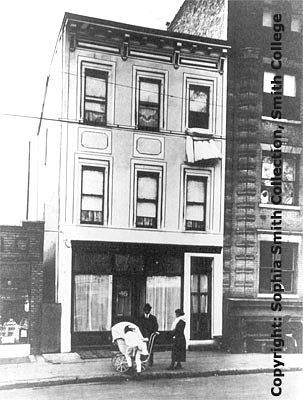Margaret Sanger’s 1916 Clinic

It was on October 16th, 1916 that Margaret Sanger opened her first family planning and birth control clinic in Brownsville, Brooklyn. Although Sanger’s groundbreaking clinic wasn’t in Greenwich Village, its politics were very much of the neighborhood, and in fact were fostered by Sanger’s deep involvement with many radical and progressive movements centered in Greenwich Village at the time.
In 1911, Margaret moved with her husband William Sanger to New York City from the Hudson River Valley. She worked as a nurse on the Lower East Side, while William was an architect. Both were deeply invested in leftist ideology, and so Greenwich Village called to them. The Sangers lived in Village for at least part of their New York City career (in 1921 she listed 346 West 14th Street as her address, and later, 39 Fifth Avenue), and Margaret certainly knew that that’s where the frank, progressive conversations were happening. Moved by the tragedy of the Triangle Shirtwaist Factory Fire in Greenwich Village, she threw herself into the social and political activity of the early 20th century Village, joining the Women’s Committee of the New York Socialist party, participating in actions with the Industrial Workers of the World (including the notable 1912 Lawrence Textile Strike and the 1913 Paterson Silk Strike). She influenced and was influenced by many of the noted intellectuals, artists and activists of the Village at the time, including John Reed, Upton Sinclair, and Emma Goldman, with whom she was particularly strongly associated.
It was in the Village that Sanger became deeply involved with the nascent feminism movement. She believed that women were kept in the dark, purposely kept uneducated and disempowered by a lack of options and education. Sanger believed strongly in changing that. She presented at meetings of the Heterodoxy Club (a Village women’s group dedicated to discourse on radical feminism and women’s suffrage), discussed sexual politics with fellow patrons at Polly’s Restaurant, and attended Mabel Dodge‘s famous 5th Avenue salon. Free love and unorthodox relationships were in the air in pre-War Village, but so was education, empowerment, and social change. Sanger believed in arming women of all ages with the knowledge necessary to make decisions about their bodies and their futures, and Village society was ripe to help Sanger strengthen those convictions and act on those beliefs.

Sanger also wrote columns in New York newspapers dispensing candid advice and information on women’s biology. In March 1914 she started her own women’s magazine called The Woman Rebel. It was also at this time that she coined and began to popularize the term “birth control.” Previously, there had been no one phrase to accurately refer to these issues – partly, of course, because the Comstock Laws made it illegal to distribute information on contraception or sex. Sanger’s work not only helped to educate the public but also to normalize these issues and breed comfort in their discussion. The Woman Rebel came under immediate fire from those anti-obscenity laws, but Sanger was not deterred. She published seven issues before the law eventually caught up to her, and she fled overseas to avoid facing trial.
Sanger’s time in the more liberal European countries was extremely educational, and it was there that she discovered methods of contraception which she believed would greatly benefit American women. In opposition to the law once again, Sanger began importing diaphragms to America from Europe. And on October 16th, 1916, she officially opened her first birth control clinic at 46 Amboy Street in Brooklyn. Sanger was immediately arrested, and upon her refusal to declare that she would respect the law going forward, she was sentenced in 30 days in a workhouse. This made national news, and it sparked a flurry of activism and fundraising that helped further the birth control movement nationwide.

In 1921, Sanger founded the American Birth Control League, which was located at 104 Fifth Avenue, just outside of the Village at 15th Street. In 1929, Sanger formed the National Committee on Federal Legislation for Birth Control to lobby to overturn restrictions on contraception. Their efforts bore fruit in 1936. A year later, Sanger became chairman of the newly formed Birth Control Council of America, and in 1946, Sanger helped found the International Committee on Planned Parenthood, which would eventually become the Planned Parenthood organization we know today. Sanger also opened a birth control research bureau which operated out of a West 16th Street townhouse from 1930 to the mid-1970’s.
Out of all that progressive foment in the bohemian Village, Margaret Sanger’s work for a more educated female population is undoubtedly among the most far reaching and influential. Although the morality and righteousness of her philosophies are still questioned, there’s no arguing that her tenacity and progressive ideals forever shaped the national conversation and landscape. Today, among fellow progressives, Sanger is a kind of saint, and people are still heralding her radical politics and unwavering efforts to affect change and improvement for women’s lives.

For more about Margaret Sanger and other similar pioneers, check out our Civil Rights and Social Justice Map at www.gvshp.org/civilrightsmap, or our ‘Transformative Women’ tour on our Greenwich Village Historic District 50th Anniversary Map at www.gvshp.org/GVHD50tour.

One response to “Margaret Sanger’s 1916 Clinic”